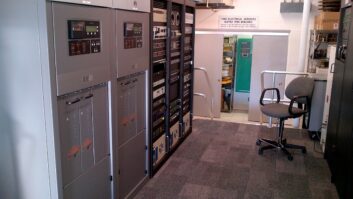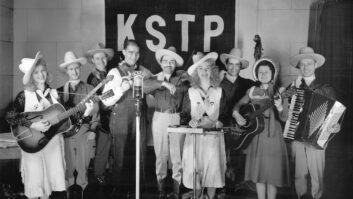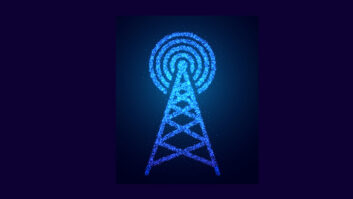
Has there been a thaw in the inter-Korean radio war of “hostile” radio broadcasts and jamming?
Hopes were raised coming out of the April 27 summit, as the leaders of the Democratic People’s Republic of Korea and the Republic of Korea declared that the nations would “cease all hostile acts against each other in every domain.”
Specifically, “ceasing as of May 1 this year, all hostile acts and eliminating their means, including broadcasting through loudspeakers and distribution of leaflets in the areas along the Military Demarcation Line.”
The loudspeaker broadcasts have indeed stopped, with Seoul going so far as the dismantle its loudspeaker network. It was thought that this might lead to a decrease or even elimination of radio broadcasting directed by the Koreas at one another, especially as the programming on the South Korean loudspeaker network has also been transmitted via FM to North Korea. As such, they might be considered a “hostile act” occurring at the Military Demarcation Line as the transmissions could be received in this area. In addition, South Korean police prevented an activist group from launching leaflet-laden balloons towards North Korea on May 5, according to press reports.
BROADCASTING, JAMMING AND MONITORING
There is a history of cross-Korean border broadcasts and jamming FM, AM and shortwave going back decades.
Jamming has also been used by both sides in all of these bands and usually consists of some sort of noise jamming. These stations’ purpose is to influence the other side, and the jammers seek to prevent that influence from taking root.
Monitoring, particularly of the widely heard shortwave services, will indicate if stations have been shut down or if there is a decrease in jamming. Such monitoring does have its limitations, even in a world with many remote receivers, especially with regards to FM.
North Korea presents its own special challenges. Apparently due to power shortages, the country is not always able to transmit on every listed frequency, nor able to jam them. So an absence of either activity might be due to lack of electricity rather than a change in policy. Also, North Korean transmitters in poor condition are sometimes heard, apparently due to inability to repair such emitters.
Radios sets are widely available in South Korea, so North Korean stations can be tuned in to them. There is a single station transmitting from North Korea to South Korea known as Echo of Unification. The station is still active, and it is still being jammed by South Korea. One of its shortwave transmitters is in poor condition and putting out a wobbly signal.
South Korea also jams certain North Korean domestic services that can be received in South Korea. There are no signs that this jamming has stopped.
The radio receiver situation is quite different in the North. The government sells fix-tuned sets that can only receive domestic broadcasts. While some tune-able sets have been smuggled in or clandestinely made, the bulk of sets are fix-tuned. There can be stiff penalties for tuning in to “foreign” broadcasts, so many broadcasts directed to North Korea are scheduled for the middle of the night, which is described as a “safe” time to listen. Like its neighbor to the South, North Korea jams some South Korean domestic services.
SOUTH-NORTH BROADCASTING
Despite the lack of receiver sets, there are several South Korean government-run stations broadcasting to North Korea. Voice of Freedom is operated by the South Korean military, and until recently, was also broadcast in part via loudspeaker. But the end of the loudspeaker broadcasts has not meant an end to the station’s transmissions on FM and shortwave. Nor has it brought an end of North Korean jamming of the station.
There are four stations reportedly operated by South Korea’s National Intelligence Service: Echo of Hope and Voice of the People are on shortwave only and operate on a number of frequencies. They remain on the air and continue to suffer from North Korean jamming. Both the AM station, Radio Free Korea and the Freedom FM Radio appear to still be available as well.
For the moment, the Koreas appear to be limiting the predicted “broadcast thaw” to loudspeakers and leaflets. Such bans on loudspeaker broadcasts are not unprecedented, nor is their eventual resumption.
If the ban last this time, the next break might be an end to their services targeting one another and the jamming associated with these services. Even in such a scenario, North Korea would still face a number of radio services it considers hostile. The countries might then stop jamming each others’ domestic broadcasts.
Only time will tell if the thaw will expand to include inter-Korean radio broadcasts and jammin, or if the countries will return to their old, cold behavior.
Other Voices
In addition to stations run by South Korea, there are a number of other broadcasts that North Korea objects to and attempts to jam. These include mainstream and well-known stations such as the BBC’s recently established Korean service and the U.S. government’s Radio Free Asia.
There are also two stations produced by the Japanese government and directed to North Korea: Sea Breeze and Wind From the Homeland. They are broadcasting on shortwave to Japanese citizens believed to have been kidnapped by North Korea and thought to still be held there.
There are also a number of NGOs broadcasting to North Korea.
Among them is National Unity Radio, a station using shortwave transmitters in Tajikistan. It is reportedly part of the Unification Media Group, which received over $500,000 in grants from the National Endowment for Democracy last year.
North Korea Reform Radio is broadcast on shortwave via Uzbekistan and received over $300,00 from the NED in 2017. North Korea jams these services.
Communist North Korea also objects to some religious broadcasts. Voice of the Martyrs and FEBC are among the stations that have been jammed.
So even if South Korea were to end all its radio services to North Korea, the jammers in the North would likely remain quite busy.







